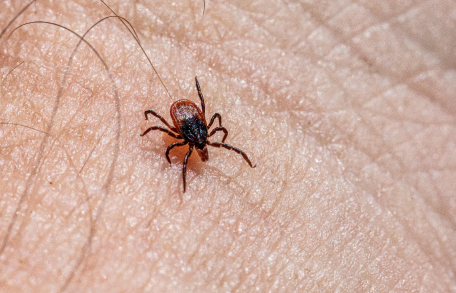Lyme Disease and Post-Lyme Syndrome
Understanding Lyme Disease and Post-Lyme Syndrome
Lyme disease is an infection caused by the bacterium Borrelia burgdorferi, and other Borrelia species, transmitted through bites from infected ticks. It is the fastest-growing vector-borne infectious disease in the United States.
Diagnosis and treatment of Lyme disease can be challenging, as many of its symptoms mimic other diseases, and Borrelia can alter its form and evade your immune system. Lyme disease diagnosis and treatment may be further complicated by co-infections such as Bartonella, Ehrlichia, Babesia, and other co-infections also transmitted by ticks, and other vectors.

If left untreated, Lyme disease can result in long-term health issues that significantly affect your quality of life. Some patients also develop Post-Lyme Syndrome, characterized by persistent symptoms after treatment, even when their initial infection has cleared.
At Michael Rothman MD, we take a comprehensive, multifaceted approach to diagnosing and treating Lyme disease. Our personalized treatment plans are tailored to address the complexities and comorbidities associated with Lyme disease, ensuring that your specific health needs are met.
Ready to Take Control of Your Health?
If you are experiencing symptoms of Lyme Disease and Post-Lyme Syndrome and are seeking effective, metabolically directed treatments, contact us online or call (732) 268-7663 for a consultation with Dr. Rothman.
What are the Symptoms of Lyme Disease?
Lyme disease can present with a range of symptoms that can vary widely between individuals, but common symptoms include:
- Bull’s-eye Rash: Often referred to as erythema migrans, this distinctive rash typically appears as a circular, red area with a clear center, resembling a target. Notably, fewer than 40% of patients with Lyme recall having this characteristic rash.
- Headaches: Persistent or severe headaches that may vary in intensity.
- Flu-like Symptoms: Episodes of fever, often accompanied by chills, nausea, vomiting, or muscle aches.
- Fatigue: Unusual tiredness that doesn’t improve with rest.
- Numbness or Tingling: Loss of sensation or “pins and needles” in certain areas.
- Neck Stiffness: Difficulty moving your neck or discomfort when turning.
- A more specific pattern seen in Lyme disease is pain and neurological symptoms that migrate to various locations.
- Related Comorbidities: Mold and food sensitivities, thyroid dysfunction, adrenal dysfunction, sex hormone dysfunction, autonomic dysfunction, and other metabolic imbalances.
Because of its difficulty to diagnose, overlapping symptoms, and substantial list of comorbidities and possible co-infections, it is vital that you consult a doctor for a proper diagnosis. Both Lyme disease and Post-Lyme Syndrome can be complex to diagnose and treat. A holistic, metabolically directed treatment approach can help restore your health and improve your overall well-being.
Causes of Lyme Disease
Lyme disease is most commonly caused by the transmission of the Borrelia burgdorferi bacterium through the bite of an infected blacklegged tick, also known as a deer tick (Ixodes scapularis). The bacterium is introduced into the bloodstream when an infected tick bites a human. Many health professionals erroneously believe that ticks must be attached for a certain period of time, at least— 24 to 48 hours—to transmit Lyme disease. However, several studies reveal that the transmission time can be significantly shorter. The blacklegged tick has a four-stage life cycle: egg, larva, nymph, and adult. It can transmit Lyme disease to humans in both the nymph and adult stages.
Spotting and timely removal of ticks are crucial in preventing infection. Several factors can increase your risk of exposure to Lyme disease, including:
- Your geographic location–Lyme disease is more prevalent in areas where blacklegged ticks are found, particularly in the northeastern, north-central, and western coastal regions of the United States. Blacklegged ticks are common throughout New Jersey.
- Your outdoor activities—Participating in outdoor activities like hiking or camping in wooded or grassy areas significantly raises your likelihood of encountering ticks.
- The temperature—While tick bites are most common during the warmer months (April to September) when they are most active, it’s important to remember that ticks can be active any time the temperature is above freezing.
- Your surrounding environment—Living in or near habitats favorable for ticks, such as forests, grasslands, and areas with dense vegetation, increases tick exposure.
If you choose to engage in activities in tick-prone areas or live in conditions where your exposure risk is higher, there are preventative measures you can take to reduce your risk of tick bites. To prevent tick bites, use insect repellent containing DEET, wear protective, bright-colored clothing such as long sleeves and pants, and conduct thorough tick checks after outdoor activities. Additionally, ensure that all of your pets are up to date on their flea and tick medications, and conduct thorough tick checks whenever they spend time outside.

Our Functional and Metabolic Medicine Approach to Lyme Disease
Diagnostic Methods Used:
- Blood tests, including the Elisa Screening Test, the Western Blot and immunoblot testing. The Elisa test checks for antibodies to the Borrelia burgdorferi bacterium, while the Western Blot test and immunoblot checks for specific banding patterns that reveal immune responses to various components of the Borrelia organism. It’s important to note that these tests often yield false negative or false positive results, especially in the early stages of the infection and in patients whose immune system may be suppressed.
- Evidence of immune suppression on laboratory tests.
- Characteristic Herxheimer reactions to clinical trials to appropriate anti-microbial agents.
- Physical exams to look for symptoms such as the characteristic erythema migrans rash.
- Evaluation of your history and exposure risk, including any recent tick bites or symptoms that may point toward Lyme disease.
- A workup for other toxins that can suppress your immune system including co-infections, mold and heavy metals
- Assessment of dietary and nutritional problems.
- In-clinic metabolic testing to determine your acid-base balance, anabolic/catabolic, and autonomic nervous system balance.
Potential Treatment Options:
- Lifestyle modifications to enhance your overall health.
- Personalized dietary modifications to treat comorbidities, reduce chronic inflammation, autonomic dysfunction, and nutrient deficiencies.
- Metabolic therapy
- Identify and address any underlying environmental issues that are stressing your body.
Why Choose Functional and Metabolic Medicine for Lyme Disease?

Could Biotoxin Exposure Be Causing Causing Your Health Struggles?
Meet Dr. Michael Rothman:
Holistic Health and Metabolic
Medicine Expert
Dr. Michael Rothman is a Functional and Metabolic Medicine Specialist with over two decades of holistic practice. Drawing on his personal experience with Crohn’s disease, he is passionate about utilizing metabolically directed functional medicine to address complex health conditions, like Lyme disease and Post-Lyme Syndrome. Dr. Rothman’s comprehensive method considers exposure risks, dietary habits, genetic predispositions, and environmental factors to identify and treat the metabolic imbalances at the root of health issues.
Certified by the National Board of Medical Examiners and the New Jersey State Board of Medical Examiners, he also holds board certifications in Internal Medicine and previously in Emergency Medicine. Dr. Rothman is a member of ILADS, the International Lyme and Associated Disease Society.
His unique approach integrates knowledge from nutrition, biochemistry, physiology, and physics, alongside extensive training in environmental illness, medical acupuncture, naturopathy, Reiki, qigong, and oriental martial arts. Patients can expect a thorough, individualized approach aimed at restoring and maintaining lasting well-being.

Ready to Take Control of Your Health?
If you are experiencing symptoms of Lyme Disease and Post-Lyme Syndrome and are seeking effective, metabolically directed treatments, contact us online or call (732) 268-7663 for a consultation with Dr. Rothman.
Frequently Asked Questions
While there are no specific foods that everyone with Lyme disease should avoid, you may benefit from avoiding inflammatory foods such as processed sugars, refined carbohydrates, and vegetable oils (soy, canola, corn…) and possibly dairy, and gluten.
At Michael Rothman MD, we will provide personalized dietary recommendations for your unique needs.
To prevent Lyme disease, you can take the following measures:
- Use insect repellent containing DEET on your skin and clothing.
- Wear protective, bright-colored clothing, such as long sleeves and long pants, when in tick-prone areas.
- Conduct thorough tick checks on yourself, pets, and children after spending time outdoors.
- Shower within two hours of outdoor activities to wash off any potential ticks.
- Avoid walking through tall grass and dense brush where ticks are commonly found.
- Keep your pets up to date on flea and tick prevention medications.








